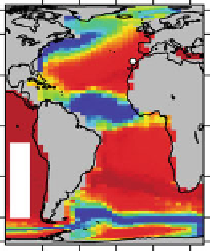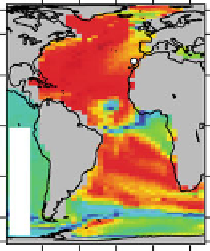Geoscience Reference
In-Depth Information
Speci
c forcing scenarios were developed to simulate internally and externally dri-
ven changes in Atlantic Meridional Overturning Circulation (AMOC) variability at a
variety of time scales. Atlantic wide anomalous heat
fluxes were imposed to create a
basin scale temperature dipole that induced changes in northward heat transport
(Heslop and Paul
2011
). Additionally, idealized freshwater forcing scenarios were
employed to reduce the strength of the simulated AMOC in a systematic manner.
Spatial
fl
fingerprints of both internally and externally forced AMOC variability were
estimated from the UVic ESCM runs using the metrics of Heslop and Paul (
2012
). In
deriving these
fingerprints attention was focused on the sensitivity, linearity and
reversibility of seawater temperature responses to changing AMOC vigor.
3 Key Findings
Statistical
fingerprints developed from the UVic ESCM model runs revealed the
optimum conditions to detect and characterize short and long term changes in
central water temperatures and their relationship to the AMOC (Heslop and Paul
2011
,
2012
). These
fingerprints showed that central water temperature on the
eastern boundary of the subtropical gyre should be a particularly sensitive and
linear indicator of AMOC strength (Fig.
1
).
Fig. 1 Paleoclimate model
fingerprints relating central water temperature properties at a depth of
860 m to AMOC strength. (Left) Sensitivities (units of
°
C/Sv) show the expected magnitude of the
seawater temperature response to a given change in AMOC strength. Red (blue) shading
corresponds to a positive (negative) relationship and darker shading indicates a larger amplitude
response. (Middle) Linearity of the seawater temperature response to changing AMOC strength.
Red (blue) shading on the normalized scale corresponds to a linear (nonlinear) relationship. (Right)
Reversibility of seawater temperature change in response to changing AMOC strength. Red (blue)
shading on the normalized scale indicates a reversible (nonreversible) relationship. Regions that
show reversible behavior will not experience serious biases in water temperature when comparing
periods of AMOC decline and recovery


























Search WWH ::

Custom Search